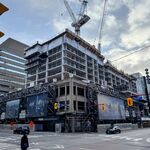Sorry, but the transit system just has so much room to improve. Improving highway capacity should only be a last resort and, in the world of today, that's almost never going to happen as there are so many ways to improve transit, and it takes up a fraction of the space that roads do. The GTA has potential for so much more transit usage than it has now. Get more people on transit, and you'll help unclog the DVP and Gardiner.
I think we can all agree that cars are bad, or at least inconvenient in some way. So why just enable them? By continuing to build car infrastructure balanced with car infrastructure, that'll just maintain the status quo. If we want to build the region better, we have to focus on transit. Building on both cars and transit is, more or less going to maintain the status quo. While both are going to be less clogged, transit is still going to have a long way to catch up with cars. And if we can improve road conditions by getting unneeded car drivers off the road en masse, it improves the lives of everyone.




